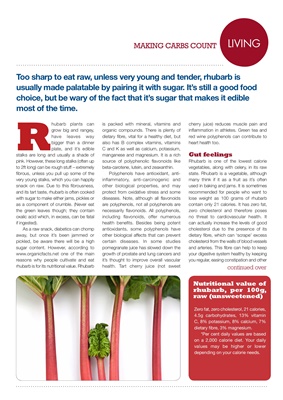
KITLIVING
Zero fat, zero cholesterol, 21 calories,
4.5g carbohydrates, 13% vitamin
C, 8% potassium, 8% calcium, 7%
dietary fibre, 3% magnesium.
*Per cent daily values are based
on a 2,000 calorie diet. Your daily
values may be higher or lower
depending on your calorie needs.
Nutritional value of
rhubarb, per 100g,
raw (unsweetened)
Too sharp to eat raw, unless very young and tender, rhubarb is
usually made palatable by pairing it with sugar. It's still a good food
choice, but be wary of the fact that it's sugar that makes it edible
most of the time.
LIVING
Rhubarb plants can
grow big and rangey,
have leaves way
bigger than a dinner
plate, and it's edible
stalks are long and usually a shade of
pink. However, these long stalks (often up
to 2ft long) can be rough stuff - extremely
fibrous, unless you pull up some of the
very young stalks, which you can happily
snack on raw. Due to this fibrousness,
and its tart taste, rhubarb is often cooked
with sugar to make either jams, pickles or
as a component of crumble. (Never eat
the green leaves though; they contain
oxalic acid which, in excess, can be fatal
if ingested).
As a raw snack, diabetics can chomp
away, but once it's been jammed or
pickled, be aware there will be a high
sugar content. However, according to
www.organicfacts.net one of the main
reasons why people cultivate and eat
rhubarb is for its nutritional value. Rhubarb
is packed with mineral, vitamins and
organic compounds. There is plenty of
dietary fibre, vital for a healthy diet, but
also has B complex vitamins, vitamins
C and K as well as calcium, potassium,
manganese and magnesium. It is a rich
source of polyphenolic flavonoids like
beta-carotene, lutein, and zeaxanthin.
Polyphenols have antioxidant, antiinflammatory,
anti-carcinogenic and
other biological properties, and may
protect from oxidative stress and some
diseases. Note, although all flavonoids are
polyphenols, polyphenols not necessarily
are flavonoids. All polyphenols, including
flavonoids, offer numerous health benefits.
Besides being potent antioxidants, some
polyphenols have other biological activities
that can prevent certain diseases. In some
studies pomegranate juice has slowed
down the growth of prostate and lung
cancers and it's thought to improve overall
vascular health. Tart cherry juice (not
sweet cherry juice) reduces muscle pain continued over
and inflammation in athletes. Green tea
and red wine polyphenols can contribute
to heart health too.
Gut feelings
Rhubarb is one of the lowest calorie
vegetables, along with celery, in its raw
state. Rhubarb is a vegetable, although
many think if it as a fruit as it's often
used in baking and jams. It is sometimes
recommended for people who want to
lose weight as 100 grams of rhubarb
contain only 21 calories. It has zero fat,
zero cholesterol and therefore poses
no threat to cardiovascular health. It
can actually increase the levels of good
cholesterol due to the presence of its
dietary fibre, which can 'scrape' excess
cholesterol from the walls of blood vessels
and arteries. This fibre can help to keep
your digestive system healthy by keeping
you regular, easing constipation and other
digestive issues.
MAKING CARBS COUNT